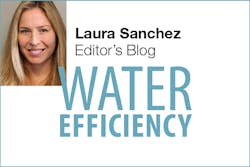“It takes a lot of water to make electricity and it takes a lot of electricity to pump, move, and, now, recycle and reuse water,” writes Joe Grindstaff, general manager of Inland Empire Utilities Agency (IEUA) on the interconnectedness of these two resources.
IEUA provides wastewater collection and treatment services to more than 875,000 people in southern California through member agencies that include Chino, Chino Hills, Cucamonga Valley Water District, Fontana, Fontana Water Co., Montclair, Monte Vista Water District, Ontario, and Upland.
In an effort to keep up with the increasing demand of these agencies, the water supplier has developed innovative ways to address energy generation, including integrating renewable energy resources into its power mix. Currently its distributed energy profile includes 3.5 MW of solar, 1MW of wind, and 2.8 MW of biofuel cell generation. Now the agency is adding energy storage to contain the power it generates for later use in “energy reservoirs.”
“We need to be able to store the power we generate, so that it can be used when customers and the grid need it most. We have learned energy self-sustainability takes more than just making power—it takes management as well.”
IEUA teamed with Advanced Microgrid Solutions (AMS) to install 3.65 MW of Tesla Energy batteries at six regional water-recycling facilities and pump stations across its service area. According to Grindstaff, the “energy reservoirs” will store excess energy generated by onsite power resources or directly from the electric grid and make it available to IEUA and the grid when needed. The resources are projected to save the agency 5 to 10 percent of its energy costs each year.
This sort of partnership between energy utilities and water agencies also means that grid operators and water utilities can help create flat base loads of cost-effective energy and optimize its usage. Advanced Microgrid Solutions is also working with Irvine Ranch Water District in Orange County on a similar 7 MW project. These projects indicate a growing opportunity for water agencies to utilize energy storage to reduce the costs of their own operations and help reduce peak demand on the grid.
“The project will serve as a model for utility agencies, as well as local and state governments, around the country,” US Rep. Norma Torres, representing Pomona, said in a statement. Do you think that this sort of collaboration between energy and water agencies with shared energy storage is a development that we will see more of in the future? Are energy reservoirs a tool that your organization is considering?
If you’re interested in other cutting-edge technologies, we’d like to recommend two upcoming webinars from Forester U. Voodoo Hydrology explores strategies for urban stormwater hydrologic design on December 1st. On December 8th, Melanie Goetz presents practical solutions for public outreach programs in Communicating the Value of Water. Join us.






